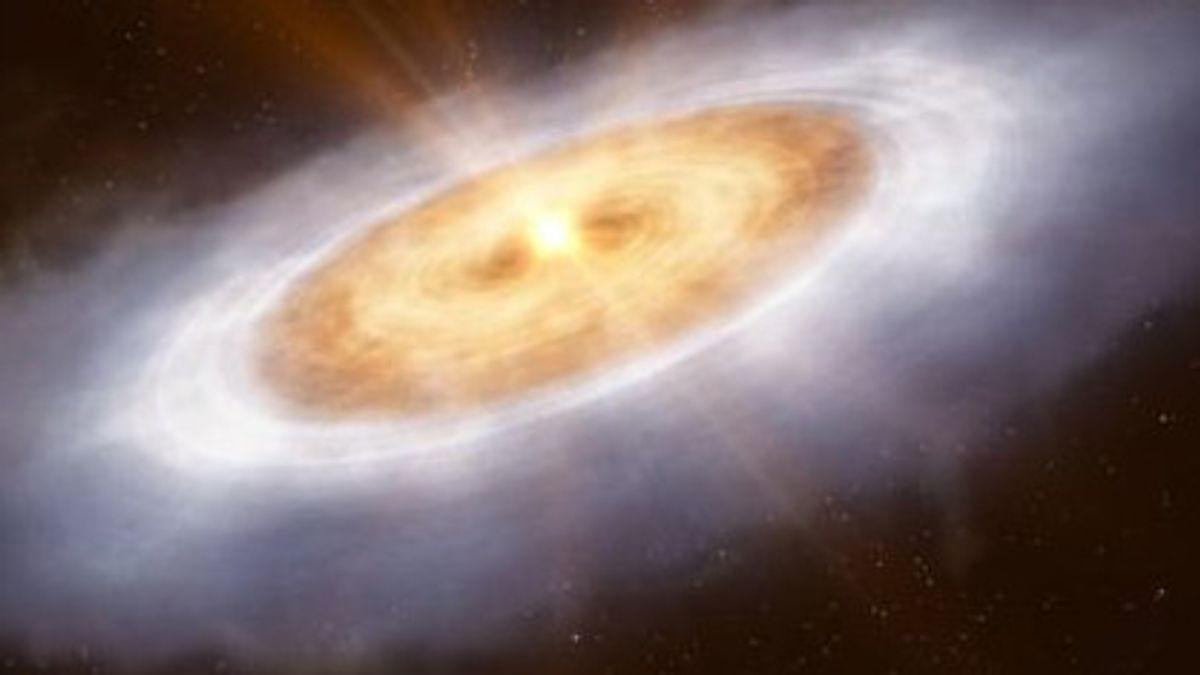JAKARTA - Armed with the Atacama Large Millimeter/submillimeter Array (ALMA), astronomers managed to reveal water was present in the Solar System billions of years before the Sun formed.
They saw gas-shaped water in the planet-forming disk around the baby star V883 Orionis, with a chemical composition very similar to the water found in the Solar System comet. Similar comets may have sent water to ancient Earth.
The V883 Orionis is a protostar located approximately 1,305 light-years from Earth in the Orion constellation, containing at least 1,200 times the amount of water across Earth's oceans.
These new observations of the protostars have helped astronomers to discover possible links between water in the interstellar medium and water in the Solar System by ensuring they have similar compositions.
"We can consider the waterway through the universe as a trace. We know what the end point is, namely water on planets and comets, but we want to trace that trail back to where the water came from," said an astronomer at the National Radio Astronomy Observatory (NRAO) at the National Science Foundation and lead author of the paper, John Tobin.
To make their discoveries, astronomers take advantage of rare atomic anomalies. Most of the water molecules are the marriage of two hydrogen atoms and one oxygen atom.
Sometimes, however, one of the hydrogen atoms is replaced by a deuterium atom, which isotopic hydrogen containing neutrons in its nucleus. The ratio of two types of water is an important chemical fingerprint, as it relies on the conditions under which they form.
Previously, we were able to connect Earth with comets, and protostars with interstellar medium, but we couldn't connect protostars with comets. The V883 Orionis has changed it, and proved that the water molecules in that system and in the Solar System we have similar deuterium and hydrogen ratios," said Tobin.
The composition of water in the disk is very similar to comets in our Solar System, "he added. Increasing, the water chemically remains unchanged when it moves from interstellar gas clouds, to the new Solar System and then to comets.
In connecting the water in the protoplanetary disk of V883 Orionis with the disk in the Solar System, astronomers measure its composition using the highly sensitive recipients of the Band 5.6mm) and Band 6 (1.3mm) ALMA.
They observe radiation emitted by water in space as it vibrates. Inside the ice, the vibrations are limited. The Orionis V883 helped the Tobin team. A dramatic burst of energy from the star heats the disk, converting water from ice into gas.
If comets are the main source of Earth's water, then astronomers' findings imply most of the water on Earth is older than the Solar System itself.
However, it remains unclear whether comets play a major role, as Earth's oceans have a lower deuterium atay ratio of hydrogen compared to the water observed around Orionis V883.
Tobin revealed, there was an explanation. Whether high temperatures reduce that ratio over time, or objects that transmit water to Earth have a ratio that is intrinsically lower so far.
Another study has designated the asteroid as the main delivery mechanism, with comets responsible only for 1 percent of Earth's water.
In this study published in the journal Nature, astronomers stated, clarifying the role of water in the development of comets and planetesimals is very important to build an understanding of how our Solar System develops.
Although the Sun is believed to have formed in a dense cluster of stars and the V883 Orionis is relatively isolated without nearby stars, both have one important similarity, forming in giant molecular clouds.
It is known that most of the water in the interstellar medium is ice-shaped on the surface of small dust grains in the clouds. When this cloud collapses due to its own gravity and forms a young star, the water ends up on the disk around them," said an astronomer at Leiden University and co-author of the paper, Margot Leemker.
Finally, said Leemker, the disk evolved and icedust grains clotmed to form a new Solar System with planets and comets, as quoted by ScitechDaily, Wednesday, March 15.
"We have shown that the water produced in the clouds follows this trail almost unchanged. So, by looking at the water in the Orionis V883 disk, we basically look into the past and see how our Solar System looks when it's much younger," Leemker explained.
The next step, astronomers will use the upcoming Extremely Large Telescope (ELT) and the upcoming Mid-infrared ELT Imager and Spectrograph (METIS) instrument to see other young Solar Systems.
According to Leemker, "This will give us a much more complete view of the ice and gas in the planet-forming disk," he concluded.
The English, Chinese, Japanese, Arabic, and French versions are automatically generated by the AI. So there may still be inaccuracies in translating, please always see Indonesian as our main language. (system supported by DigitalSiber.id)








